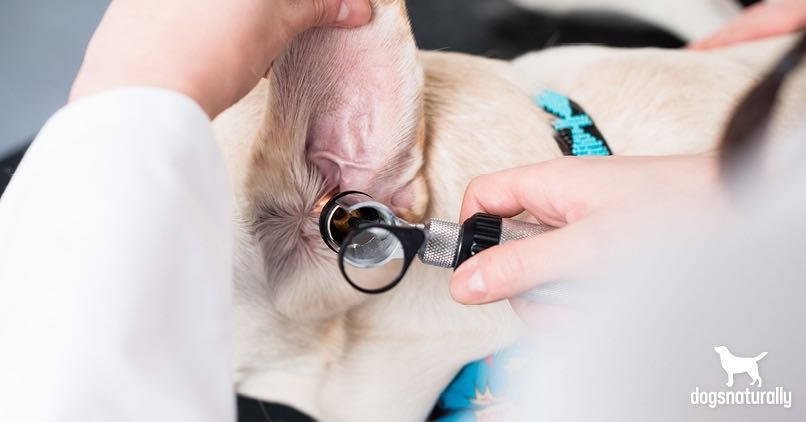If your dog’s shaking her head or scratching her ears, ear mites in dogs may be to blame.
The good news is … unlike other parasites, ear mites in dogs don’t bite or burrow. The bad news is … they’re very contagious and can cause worse problems if left untreated. So it’s important to act quickly if your dog has ear mites. You need to stop the spread and stop your dog from injuring herself.
So here’s some information about ear mites, how to identify these pests … and how to get rid of them.
What Are Ear Mites (Otodectes cynotis)?
Sometimes people say “ear mites” to refer to mange (sarcoptic or demodectic).
But there’s a specific kind of ear mite we’ll cover in this post. It’s called Otodectes cynotis and it’s one of the most common types of ear mites (1). It’s also a type of mange, also called Otodectic mange
So what are these annoying little pests? They’re actually arachnids … the same family as ticks, spiders and scorpions. But unlike their cousins, they don’t bite.
Ear mites usually live in your dog’s ear canal … but occasionally on the body. They feed off wax and oils in your dog’s ears. And that makes your dog itchy.
Ear mites are parasites. They don’t live long without a host … so when they find your dog, they’re eager to move in and set up house. And the ear canal is a nice cozy place to live and eat.
These mites are more common in cats … but your dog can pick them up too. They’re also quite contagious to other dogs, cats and ferrets. So if you have other pets, you’ll want to tackle the problem quickly. (Don’t worry, ear mites don’t usually affect humans. Rarely, people might get a skin rash from them.)
Younger dogs may be more susceptible to ear mites. But any age dog can get them.
How Dogs Catch Ear Mites
Your dog can pick up ear mites from the outdoors. But most often they come from another animal … a dog, cat or ferret. Outdoor cats are a common source of infection. (Foxes also get ear mites … but your dog probably isn’t hanging out with them!)
According to the Companion Animal Parasite Council, cats may have 1000 mites in each ear. Dogs usually have far fewer. (The site also has some good enlarged photos of ear mites … in case you want to see what they look like!)
Once your dog gets ear mites, they spread fast. Female mites can lay 15-20 eggs during their few weeks’ lifetime. The eggs hatch in 4 days … then the offspring lay more eggs themselves. The egg-to-egg cycle takes about 18-28 days.
As mentioned, they spread easily, not just on your dog, but to your other pets. So if your dog has ear mites, check your cat or ferret too. You may need to treat them as well.
Ear mites are almost invisible to the naked eye. And the symptoms are similar to other ear problems.
Signs Your Dog Might Have Ear Mites
You might notice some of these signs of ear mites in your dog.
- Ear scratching
- Head shaking
- Droopy ears (if your dog normally has upright ears)
- Dark discharge – reddish brown, like coffee grounds
- Ears may smell bad
- Skin lesions around the ear (from your dog scratching – and they can get infected)
- Pinprick sized white spots moving about
Left to their own devices, ear mites can cause some worse problems. If you don’t get rid of them, ear mites (and your dog’s scratching) can lead to …
- Hearing loss
- Loss of balance
- Damage to the external or inner ear
- Ear hematoma
- Ear sensitivity
- Secondary infection
So you’ll want to clear up the problem before it goes too far. To make sure it’s really ear mites, and not some other ear infection, you might need your vet’s help. Or maybe not! Keep reading to see how to avoid a vet visit.
How To Diagnose Ear Mites In Dogs
You may be able to identify ear mites on your own, without a visit to the vet. Here’s how to do it.
- Use a swab or cotton ball to collect some debris from the outer ear canal
- Place it on a dark background.
- Look at it through a magnifying glass.
- Look for white, moving specks – about the size of a pin head.
If that’s what you see, they’re likely mites. If you don’t see them, give it another try. Take debris from a different spot, or the other ear … in case your first sample missed picking up the mites. If you still don’t see any little white creepy-crawlies … you can ask your vet to have a look.
But you can also skip the vet visit and try one of the 3 remedies suggested below. They’re good general ear remedies that can work for ear mites too.
If you do go to the vet … diagnosing ear mites should be easy.
- Your vet should be able to confirm ear mites with a visual examination, using an otoscope.
- He may need to look at the discharge under a microscope.
Caution: If your dog’s very itchy and wriggly, some vets may want to sedate her for the exam. Try to avoid this unnecessary drugging of your dog! If you think she might be hard to examine, give her some calming Rescue Remedy or CBD oil before going to the clinic.
If your vet rules out ear mites, it could be some other kind of ear infection. Here’s some information about different ear problems to help you find out what’s going on.
But … what if your vet confirms it’s ear mites? If you have a conventional vet, he’ll want to treat your dog with drugs or pesticides. And that’s the time to say no thank you.
Treating Ear Mites in Dogs
Let’s look at some common ear mite drugs and see why natural remedies are best (and safest) for your dog.
First … your vet may want to clean your dog’s ears with a medicated solution. Medicated ear cleaners will disrupt the microbiome in your dog’s ears. They’ll make her more likely to get ear infections in future.
Then he may prescribe a pharmaceutical anti-parasitic or pesticide, such as …
- Topical anti-parasitics like Revolution or Advantage.
- Injectable or oral pesticides like ivermectin (Ivomec) or Bravecto..
You may recognize the names of some of the drugs above. They’re the same ones vets sell for flea and tick or heartworm prevention. And they’re poisons you should avoid if you can. Some vets may also prescribe antibiotics or anti-fungals in case of secondary infection.
Side Effects Of Ear Mite Medications
All of these treatments are risky for your dog. Most of them work by paralyzing the parasite (whether flea, tick or heartworm). The drugs are neurotoxins so they can also harm your dog. Some serious side effects can include:
- Tremors
- Seizures
- Ataxia (incoordination)
- Vomiting or diarrhea
- Loss of appetite
- Skin irritations
- Lethargy
Mites have a 3 week lifecycle … and the drugs only kill mature mites. That means getting rid of mites can take a few weeks, so your dog may be on the drugs for quite a while.
So, here are some safer options to get rid of dog ear mites.
3 Home Remedies For Ear Mites In Dogs
Keep in mind that your other pets may also have ear mites. Check all of them and if they do, you’ll need to use the remedies on everyone!
These are much gentler choices to clean your dog’s ears than medicated solutions … and they’ll get rid of ear mites in dogs too. Here are some ways to treat ear mites naturally.
#1 Olive Oil
In the Manual of Natural Veterinary Medicine … veterinarians Susan G Wynne DVM and Steve Marsden DVM recommend this approach:
- Clean the ear with olive oil
- Remove as much debris as possible
- The oil helps asphyxiate the mites
- Repeat this every 3 days for 2 weeks
Because ear mites hatch every 4 days, this schedule will get rid of the mites.
Bonus: You can add 1-3 drops of one of these essential oils per 1 oz of olive oil, to speed up your dog’s recovery:
- Peppermint (for its anesthetic effect)
- Catnip (helps control mites)
- St John’s Wort (Hypericum) relieves pain
- Calendula (heals the ear skin)
#2 Garlic Oil
Herbalists Mary Wulff and Greg Tilford (Herbs For Pets) recommend garlic oil for ear mite treatment. That’s because garlic contains sulphur and mites hate it, so it’s a good anti-parasitic. Garlic is also antibacterial and antifungal, so it can help with any secondary infection caused by ear mite infestations.
You can buy garlic oil in health stores … or make your own by crushing a couple of garlic cloves in a cup of olive oil. Let it sit overnight, then remove the garlic and store the oil in a glass jar.
Apply the oil to the ear twice a day. (Your dog may smell a bit like an Italian restaurant!)
#3 Green Tea
Green tea is a natural antiseptic that will get rid of mites. It’ll also help remove the “coffee grounds” debris that ear mite infestation is notorious for.
- Use a tea bag or a tablespoon of loose green tea in a cup of hot water
- Steep for a few minutes then strain
- Let it cool to room temperature
- Use a dropper to put 3-4 drops of tea in each ear
- Massage your dog’s ears gently (she should love this!)
- Then dip a cotton ball in the tea and wipe inside her ears
Do this once a day for 4 weeks to help kill ear mites.
Of course, it’s always best to prevent these parasites in the first place. So how can you do that?
How To Prevent Dogs Ear Mites
As always … the best way to prevent any parasites from choosing your dog is to make sure she’s in the best health possible. She needs a robust immune system to make her less attractive as a mite B&B host.
Here are some things that can prevent an ear mite infestation before it takes hold:
- Feed your dog the best whole food, raw diet you can afford.
- Don’t over-vaccinate – only give the shots your dog really needs
- Avoid antibiotics and other pharmaceutical drugs and pesticides – use natural alternatives.
- Minimize chemicals in your dog’s environment.
- Use natural cleaning supplies in your home
- Skip the lawn chemicals and fertilizers in your yard
- Bathe your dog with all-natural all natural organic shampoo
Should You Clean Your Dog’s Ears To Prevent Dog Ear Mites?
Some experts recommend daily cleaning to prevent ear mites or other ear problems. But over-cleaning disrupts the balance of healthy bacteria in your dog’s ears. Even if you can see a bit of ear crud, it usually clears itself up over time. It’s best to leave your dog’s ears alone unless she’s uncomfortable.
So just keep an eye on your dog’s ears regularly to make sure she doesn’t get another infestation. If you see something starting, use one of the above remedies right away. Even if your dog has a different kind of ear infection, these 3 remedies can help with those too.
Oh, and try to keep your pets away from that neighborhood outdoor or feral cat who could be carrying them!
But if your dog does get ear mites, now you know some simple and safe ways to get rid of them.
FAQ
How do you get rid of ear mites in dogs?
To eliminate ear mite infestations in dogs, clean the affected ears with a gentle cleanser to remove debris. Then, apply a natural anti-parasitic topical specifically for ear mites. In severe cases, a vet may prescribe medications like ivermectin or selamectin.
How can you tell if a dog has ear mites?
There are a few symptoms of ear mites to watch for. Excessive scratching of the ears, head shaking, a strong odor, and a dark, coffee ground-like discharge in the ear canal are major signs. You may also notice other ear irritation symptoms, like your dog’s ears appearing red and inflamed.
What kills ear mites naturally?
You can use natural treatment options to help kill ear mites, including the application of green tea or olive oil in the ears, which can soothe irritation and smother the mites. These can help to loosen the debris in the ear canal and suffocate the mites.
Can humans get ear mites from dogs?
Many people wonder “can humans catch ear mites in dogs?” It’s extremely rare and unlikely, but yes, humans can technically contract ear mites from dogs. However, human infection is transient and typically resolves on its own, as these mites prefer the ear environment of pets over humans.
References
- J Lohse et al. Validity of species status of the parasitic mite Otodectes cynotis. Medical and Veterinary Entomology. Vol. 15 Issue 2, June 2002.












